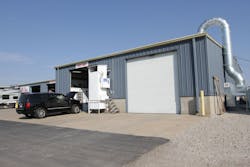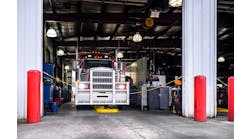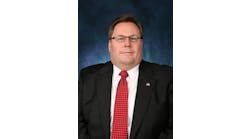Upon entering Complete Car & RV Repair (St. Charles, MO.), you might hear a friendly (or at least familiar) greeting:
“Hello!”
“She shoots, she scores!”
“Welcome!”
That would be Gonzo, the Amazon parrot. At 17 years old, he’s as talkative as ever. Gonzo is just one of the many factors contributing to Kim Barks’ success. In her early 30s, Barks decided to help co-run the business with her father and accelerated it to more than $2.8 million in annual revenue. With a background in marketing and a gregarious, go-go-go lifestyle, Barks is seemingly everywhere, doing everything she can to promote her shop, offering maximum quality repairs—no matter how difficult (or how often Gonzo squawks).
“Every day is a different day in this industry,” Barks says. “It’s changing all the time, but you still have to repair the vehicle—that’s the bottom line. It doesn’t matter what it costs.”
It’s expensive to run a business; it’s expensive to repair the most demanding vehicles most people will ever drive or see in the shop. Barks’ secret to success isn’t magic—it’s marketing.
If You Support Your Community, They’ll Support You
“You want to raise your standard,” Barks says, referring to her volunteer and philanthropic efforts, adding (with a laugh), “We’re in parades a lot!”
Good marketing isn’t sending the name of your company out into the wild blue or digital ether; it involves timely, specific messages to key demographics most willing to see, hear and respond to your efforts. That’s why Barks and the shop participate in as much as possible to show the community that Complete Car & RV Repair is there to help, to repair their vehicles, to keep their clients’ families and businesses safe.
“It’s about building trust,” Barks says, firing off a litany of community endeavors: Rotary Club appearances; Animal Humane Society contributions and events; Gateway Guardians, a shop-funded van that helps strays and other animals at risk around the St. Louis metro area. She supports an organization called Backstoppers, a huge nonprofit that supports police, fire and EMS families in times of crisis or need. She also contributes to various women in auto care classes and events, educating a growing demographic of women who are discovering just how viable and rewarding a career in automotive repair can be. The shop even has a fire truck named Red that Barks’ father drove during his days as a firefighter decades ago, and Red spends as much time in the community promoting Complete Car & RV as it does sitting near the shop. For Barks, all this work isn’t just about branding—it’s about education.
“I want to educate the public and it’s like pulling teeth,” she says. “We are on your side, and many don’t want to hear that, especially from a woman. The fact is, I’m in this every day, and I have to show them. Marketing is important because people still don’t know where to go to fix their cars. They don’t understand it’s normal, and that’s OK! That’s how we should educate. There’s not enough shops educating their communities about what is possible.”
Barks’ facility is 18,000 square feet and they conduct everything from heavy-duty body work down to light-duty collision repair and even motorcycle collision repair. They also do glass replacement, decal remove/install, and small box and tailgate work. They have four dedicated bays to body work and one large paint booth.
“We do pretty much everything,” Barks says, with the caveat that, as heavy duty materials and technology continue to evolve, they’re keeping up as much as possible. “We’re learning that we have to fabricate quite a bit for RVs as the parts are obsolete or limited.”
Parts have always been more scarce in heavy duty, and Barks does what she can to secure as many as possible from single sources.
Nonetheless, she says, “We shop around the aftermarket quite a bit and often get what we need from salvage. Sometimes we have to repair it and make it repair-ready. But if you have fixable parts, we’re going to buy them from you and we’ll do it right.”
Barks also works with automotive recyclers, adding that they offer a valuable service and are often state-of-the-art, top-notch facilities that can help shops like hers.
The Insurance Dilemma
As insurance total thresholds continue to diminish due to OE recommendations, the balance between being able to do the work and save the repair remains a struggle for Barks and many other heavy duty collision repair shops.
“Many insurance companies won’t pay for new parts, so we look to the aftermarket,” she says. “We’re writing line-by-line operations with the insurance companies on many fixes, and most insurers don’t even send a person.”
Barks employs someone full-time just to update people on their repairs because the insurance companies “don’t do anything” in that regard; “They want us and the customer to do all the work. So we do,” she says.
Barks has found she often has to wait days for an adjuster to appear while a vehicle takes up precious space at her shop, inconveniencing its owner and her staff. Recently, she had a vehicle locked up for almost three months because the insurance company couldn’t reach a decision on the repair—meanwhile, the client wanted the truck back and Barks couldn’t fix it until she received insurance authorization.
“This isn’t a free lot, and I have to deal with that, too. We’re not just a yard—we’re an active facility,” she says.
Lately, Barks and her staff have taken a different approach to their estimates. She writes an estimate in addition to the insurance company’s estimate, and they can supplement off her if they like.
“They’re cutting down field adjusters, they’re hiring second and third parties, and I end up stalking five people because I have to get paid,” she says. “Who is paying? When are they paying? What are they paying for? Who authorized it? I often record the conversation to protect my business or carbon-copy the customer or insurance company for maximum transparency.”
Barks pauses, then adds, “If we had more tools, we could offer more to our customers.”
Barks employs 17 and is pushing the heavy-duty RV and truck repair as much as possible, as her shop is one of the only in the area and she wants to be known as the top quality repairer.
“Heavy duty collision repair is our bread and butter and that’s what we like to do,” she says. “You always need cash flow—that parrot’s not going to feed itself!”
Barks says the technological rush hasn’t really affected her...yet.
“It’s really a toss-up,” she says, “because the technology hasn’t caused us any problems yet, but I don’t know what tomorrow brings. We always talk to the dealer if there’s something we can’t scan. We would never let anything leave without being safe.”
Furthermore, she sticks to her guns and demands excellence and safety from herself, her staff and her repairs.
“Nothing’s changed besides the technology has increased, and that doesn’t change the procedure—bring it in, tear it down, blueprint it, get it into the computer, look up any safety notices or recalls,” Barks says. “My team knows what’s expected of them no matter the vehicle. If we don’t give it a final inspection and if it’s not cleared, it doesn’t go.”
Barks estimates that Complete Car & RV Repair currently hauls in about $2.8 million in annual revenue, but she’s hopeful her marketing efforts and commitment to her customers will drive that number over $3 million in the next year or so.
“I go into RV and truck shops to see how they’re run and what we can learn from each other,” she says. “In this business, you can’t shy away.”



